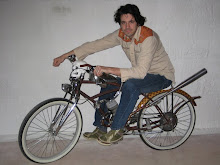

This past week I have been designing the Ontario Art Council Grant guitar. I asked my lovely wife Annette to be a part of the process. She's an aesthetician by trade so who else would be better to consult on how this "show stopper" guitar should look?
Annette really likes the checkerboard guitars. So we decided that a subtle contrast checkerboard pattered guitar would be tres cool. I found some gorgeous air dried highly figured Claro Walnut, on line, and pressed the "buy it now" button. The sides of this double cutaway will be checkered with highly figured Cooked Flame Maple and the highly figured Claro Walnut. The back plate will be carved from a killer piece of figured Claro Walnut, quarter sawn and book matched. The whole guitar will shimmer in hues of gold and rich browns.
The top wood has not been finalized but I'm thinking I'd like to try Mahogany. I want to finish the top in a solid antique Ivory, like Mary Lou W, and I need a stable wood that is dense/hard enough to anchor all the parts to. I will be using a fixed metal roller bridge and a bigsby B50 tailpiece. Both of these parts are anchored to the top wood so I need it to be robust enough to hold the various screws and inserts.
I have designed this guitar to be like a semi hollow body. Basically it will be a solid body guitar where the pickups and hardware lie. The TV Jones pickups will have a routed cavity with a flooring of wood - this helps fight feedback and creates better sustain. The design uses a sustain block of mass, as just described, but the back plate will be left to vibrate freely - the sustain block is glued to the top wood but does not come in contact with the back plate at all. This kind of design will produce a nice balance of feedback control, tone with plenty of sustain and a bit of airy archtop sound mixed in.
The rim sides will have a 2 1/2" depth with a 17" lower bout. I may reduce the f hole size a touch too - again for the sake of feedback.
The only unknown right now is how the bigsby will perform. Usually for an archtop one would use a hinged bigsby that anchors to the guitar's sides at the tailblock. I would have to have the hinge custom machined and that simply is not in the budget. My concern is having an arched top with a lowish bridge. I need to calculate what an acceptable string break angle should be. This shouldn't be too hard to figure out.
This axe is going to be pretty Bad Ass. Guarowtee!











